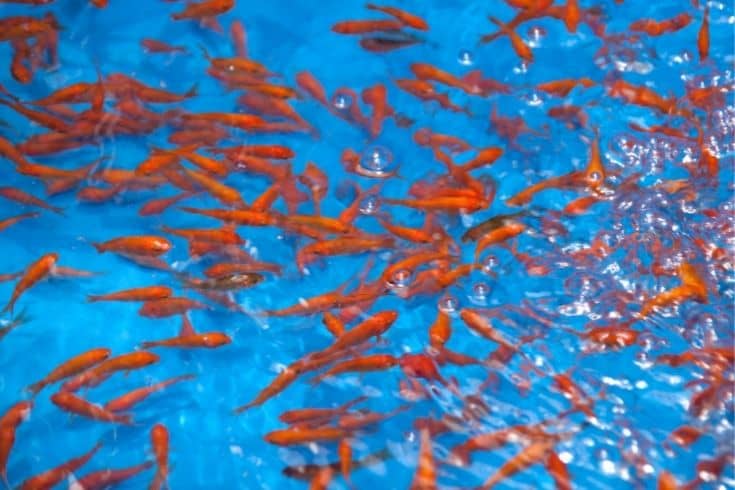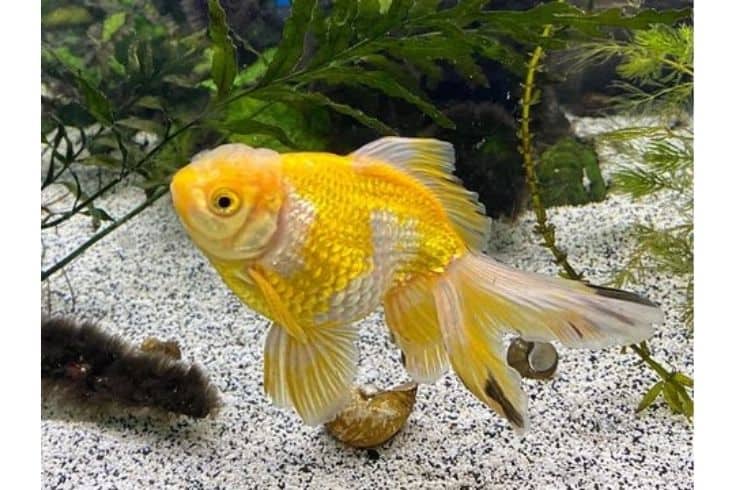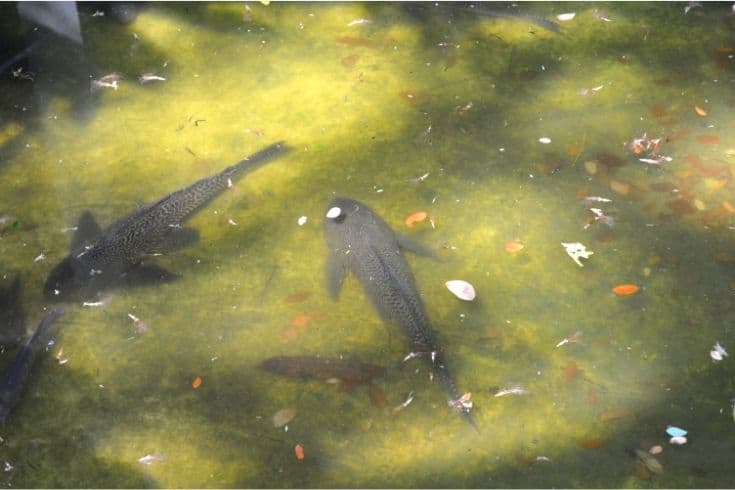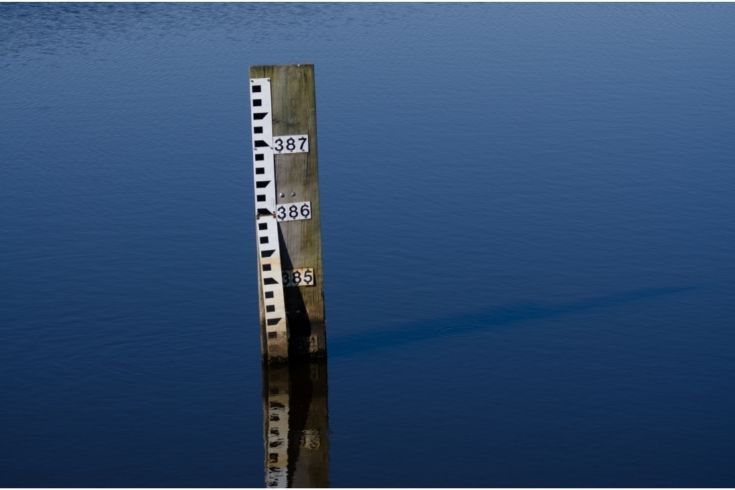You’re thinking about getting a goldfish, or maybe you’ve already got one (or two, or three…). But how many goldfish can you keep in your pond?
The good news is that if you’re keeping goldfish in a pond instead of a tank, you’ll have a lot more freedom to add fish. Ponds come in all shapes and sizes, but even the smallest ponds will measure at least 100 gallons. In this article, we will look at how many goldfish you can keep in these smaller ponds – specifically 100-gallon and 125-gallon ponds.
Goldfish Are Some Of The Best-Known Pond Fish!
Many people mistakenly assume that goldfish should be kept in bowls. They envision a butterfly fancy goldfish swimming about in a little globe of water on the coffee table, long fins trailing behind. While this might look nice, it’s not the best way to care for a goldfish. In fact, goldfish bowls are one of the main reasons why goldfish have such a bad reputation for being short-lived.
Goldfish are actually quite hardy fish, making especially hardy pond fish. As cold-water fish, they have no problem surviving in water that is a bit cooler than what tropical fish need. They are also not fussy eaters, and they will do well on a diet of pellets or flakes.
The only real problem with goldfish is that they grow. A lot. Goldfish can easily reach 12 inches in length, and some have been known to grow even larger. This makes a pond ecosystem perfect for them. A 100-gallon pond is big enough for several goldfish to swim about and be happy.
A 125-gallon pond is even better, as it gives the fish even more room to grow and move about.
How Many Goldfish Can I Have In My 100 Or 125-Gallon Pond?

So, how many goldfish can you have in a 100 or 125-gallon pond? As with most things in the world of aquariums and ponds, the answer is “it depends.” A typical pond stocking strategy is to add one common goldfish per 10 gallons of water. This means that in a 100-gallon pond, you could have 10 fish. And in a 125-gallon pond, you could have 12-13 fish.
However, because goldfish tend to be messier than other pond fish, you might want to slightly adjust this stocking density. A more conservative rule for stocking a goldfish pond would be one fish per 20 gallons of water. This means that, in a 100-gallon pond, you could have five goldfish. In a 125-gallon pond, you could have six or seven.
Of course, the more fish you have in your pond, the more filtration you will need to keep the water clean. If you have a lot of fish in a small pond, you might need to do weekly water changes to keep the ammonia and nitrite levels in check. There’s no specific rule of thumb suggesting how often you should do water changes, but a good approach is to change 10-20% of the pond’s water every week.
What Affects The Number of Goldfish You Can Keep In A Pond?
We’ve briefly touched upon a few factors that will affect how many goldfish you can keep in your pond. These include:
Goldfish Size
As we mentioned, goldfish can grow quite large. If you have a lot of big fish in your pond, they will produce more waste. Add this to the fact that goldfish are already pretty messy fish, and you have a recipe for a pond that will need a lot of filtration and maintenance.

While the 10-20 gallon per fish rule we mentioned earlier serves as an excellent general guideline, some hobbyists prefer the “gallons per inch” approach. According to this rule, you should have at least 1 gallon of water available for every inch of fish you have in your pond. Both methods will result in a similar stocking density, but the latter requires that you measure your fish to get an accurate number.
For that reason, we recommend sticking to the 10-20 gallon per fish stocking rule, which is based on the size of an average adult goldfish (10 inches of fish equates to 10 gallons of water). After all, even if your pet goldfish are small right now, they will eventually grow to their full size.
Pond Setup
The type of pond you have will also affect the stocking density. If you have a lot of submerged pond plants, for example, they will help absorb some of the waste produced by your fish. This means that you can have a higher stocking density without worrying about the water quality plunging. You might still need to do regular water changes, but not as often as you would if your pond had no plants.
Decorative elements can also affect the stocking density. If you have a waterfall-type feature in your pond, for example, the rushing water will help to oxygenate the water and make it easier for fish to breathe. However, this may also decrease the amount of available space in your pond, as the fish will have to compete for space with the waterfall.
As a result, you might need to adjust the stocking density downwards if you have this feature in your pond.
Tankmates
An oft-overlooked factor that will affect stocking density is the other fish you have in your pond. If you only intend to stock goldfish in your pond, great! However, most hobbyists will opt for a mix of different fish species. A common combination is goldfish and koi, as they are both members of the carp family.
We’ve written a full article on whether or not koi and goldfish should be kept together, and recommended that adult koi be kept separate from goldfish. This is because an adult-sized koi can easily outcompete a goldfish for food, and may even eat smaller goldfish.
However, you can keep koi and goldfish together if the fish are of similar size – this usually involves juvenile koi being kept with adult goldfish. If you do opt to keep a mix of fish in your pond, the stocking density will be lower than if you were just keeping goldfish.
Instead of keeping 10-15 goldfish in a 100-125 gallon tank, you might find yourself with only 3-4 goldfish and 5-6 koi. This is because the fish will need more space to themselves and because you’ll need to consider the bio-load of the other fish species.
Special Considerations For Goldfish Ponds
If you haven’t guessed by now, goldfish are rather high-maintenance fish. They are messy eaters, and produce a lot of waste. They also need quite a bit of space to swim, and prefer water that is on the cooler side. For these reasons, goldfish ponds require quite a bit of work to set up and maintain. Before you stock your goldfish pond, here are a few things you’ll need to consider.
Pond Type
As we mentioned earlier, the size and type of pond you have will affect how many goldfish you can keep. If you are using a small preformed pond liner, you might only be able to keep a few goldfish. This is because preformed ponds are often too shallow for goldfish. An indoor pond, such as balcony ponds or those used as part of a water feature, will also require a more conservative stocking approach

On the other hand, if you have an outdoor pond at least 3 feet deep, you will have a lot more space to work with. Garden ponds are often home to a wide variety of fish, including goldfish, koi, and even pond snails. We often recommend a larger, deeper pond for goldfish, as they will appreciate the extra space to swim.
If you have a pond of this size, you will likely be able to keep 10-15 goldfish without any issues.
Pond Maintenance
A well-maintained pond is vital in raising healthy goldfish, as these are messy fish with highly specific needs. Filters are a must in goldfish ponds, as they help to remove the waste produced by the fish. Nothing fills a pond with ammonia more quickly than a few goldfish, and an ammonia spike can be lethal to your fish.
There are several types of pond filters on the market, and we recommend that you choose one specifically designed for goldfish ponds. A good pond filter will have plenty of room for media, and will be able to handle the heavy bio-load produced by goldfish.
In addition to a filter, you will also require a pond pump and potentially, a heater. Goldfish don’t require a warm-water pond, but they can’t survive in freezing cold conditions either. Heaters warm your pond in winter, and can help to maintain a consistent pond water temperature throughout the year.
Pond Depth

The final consideration is the depth of your pond. As we mentioned earlier, goldfish need quite a bit of space to swim. They spend a lot of time swimming around the bottom of the pond in search of food, but they are not bottom dwellers in the same way that catfish are.
Instead, goldfish prefer to have a pond with plenty of room to swim at all depths. A 3 feet deep pond will give your goldfish plenty of space to explore and provide them with the cooler water temperatures they prefer. Having tiny areas where the water is just a couple of inches deep is also beneficial, as it provides your fish with a place to rest if they need it.
An average size pond, particularly one that measures between 100 and 125 gallon, will be between 2-4 feet deep. So, you should have no problem accommodating a few goldfish in a pond of this size.
The Takeaway
Now that you know more about goldfish ponds, you can decide how many fish you would like to keep in a 100 and 125-gallon pond. As a general rule of thumb, we recommend stocking your pond with no more than 10 fish for every 100 gallons of water. This will give your fish plenty of space to swim, and keep them healthy for years to come!
Did you enjoy this article? Check out our other goldfish care articles for more information on how to care for your pet goldfish!
